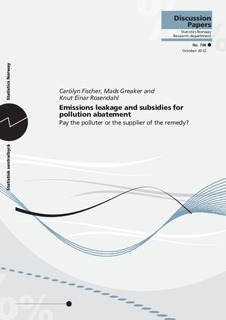| dc.contributor.author | Fischer, Carolyn | |
| dc.contributor.author | Greaker, Mads | |
| dc.contributor.author | Rosendahl, Knut Einar | |
| dc.coverage.spatial | Norway | nb_NO |
| dc.date.accessioned | 2019-11-13T09:31:20Z | |
| dc.date.available | 2019-11-13T09:31:20Z | |
| dc.date.issued | 2012-10 | |
| dc.identifier.issn | 0809-733X | |
| dc.identifier.uri | http://hdl.handle.net/11250/2628084 | |
| dc.description.abstract | Asymmetric regulation of a global pollutant between countries can alter the competitiveness of industries and lead to emissions leakage. For most types of pollution, abatement technologies are available for firms to produce with lower emissions. However, the suppliers of those technologies tend to be less than perfectly competitive, particularly when both emissions regulations and advanced technologies are new. In this context of twin market failures, we consider the relative effects and desirability of subsidies for abatement technology. We find a more robust recommendation for upstream subsidies than for downstream subsidies. Downstream subsidies tend to increase global abatement technology prices, reduce pollution abatement abroad and increase emission leakage. On the contrary, upstream subsidies reduce abatement technology prices, and hence also emissions leakage. | nb_NO |
| dc.description.sponsorship | Research Council of Norway (Renergi, CREE) Entwined-Mistra. | nb_NO |
| dc.language.iso | eng | nb_NO |
| dc.publisher | Statistisk sentralbyrå | nb_NO |
| dc.relation.ispartofseries | Discussion papers;708 | |
| dc.subject | JEL classification: Q54 | nb_NO |
| dc.subject | JEL classification: H23 | nb_NO |
| dc.subject | JEL classification: L13 | nb_NO |
| dc.title | Emissions leakage and subsidies for pollution abatement. Pay the polluter or the supplier of the remedy? | nb_NO |
| dc.type | Working paper | nb_NO |
| dc.description.version | publishedVersion | nb_NO |
| dc.subject.nsi | VDP::Matematikk og Naturvitenskap: 400::Matematikk: 410::Statistikk: 412 | nb_NO |
| dc.source.pagenumber | 38 | nb_NO |
